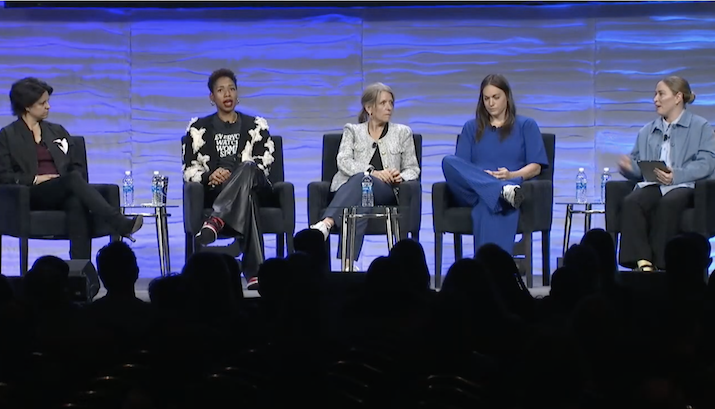MIT Sloan Sports Analytics Conference Provides Panel on Investing in Women’s Sports
Five women executives urge capitalizing on growth in media coverage
Story Highlights
Women’s sports have seen their share of media coverage increase from 4% historically to 15% in 2023, according to a study conducted by sports and entertainment agency Wasserman. Speaking on a panel titled “Limelight: Investing in the Future of Women’s Sports” at the recent MIT Sloan Sports Analytics Conference, women executives discussed how to elevate women’s sports and female athletes even further, the nuances of marketing women’s sports versus men’s sports, and some success stories to date.
Asked about providing female athletes more visibility on different media platforms, ESPN Analyst, NBA, WNBA, and College Basketball, Monica McNutt said, “Women’s sports genuinely have to be watercooler material. It’s not necessarily on these athletes. … It’s just got to continue to become mainstream.”
She added that she has recently noticed a more intelligent and informed conversation occurring on X (formerly Twitter) around some women’s sports, such as college basketball. In addition, McNutt, who played college basketball at Georgetown, cited fans’ ability to gamble on women’s college basketball as another positive for the sport as stakeholders look to drive further engagement.

The “Limelight: Investing in the Future of Women’s Sports” panel at the MIT Sloan Sports Analytics Conference: (from left) Julie Uhrman, president/CO-founder, Angel City Football Club (ACFC); Monica McNutt, analyst, NBA, WNBA, and college basketball, ESPN; Thayer Lavielle, EVP, The Collective, Wasserman; Susie Piotrkowski, VP, women’s sports programming and espnW, ESPN; and Justine Brown, VP, creative development and talent relations, TOGETHXR
Some panelists highlighted the need for opinions on women’s sports.
“People I speak to all the time,” said panel moderator Justine Brown, VP, creative development and talent relations, TOGETHXR, a media and commerce company, “are actually on the side of ‘We need takes in women’s sports — good, bad. Takes drive watercooler discussion. Watercooler discussion drives engagement. Engagement drives money.”
Added Susie Piotrkowski, VP, Women’s Sports Programming and espnW, ESPN, “It can be a bad take. Have a bad take — I’m good with it.” She emphasized that the fan’s or commentator’s opinion should not be “inherently misogynistic.
“Let’s debate it,” she continued. “I don’t care what your fandom is as long as it’s authentic to sport being sport. That’s where we still have to make progress.”
Piotrkowski, who joined ESPN in September 2022, shared one example of how the women’s sports ecosystem can be developed. In January, hearing that Jessica Smith, former head of revenue at NWSL’s Angel City, was set to be named president of the Golden State Warriors’ WNBA expansion team, she alerted her colleague Maria Soares, SVP, production and content strategy, ESPN, who leads SportsCenter programming.
“I said, ‘I have a great friend,” Piotrkowski explained. “She is about to be announced as the president. We should put this on SportsCenter.’ [Soares] said, ‘Absolutely. It’s news.’ [Soares] is a true co-conspirator. She knows it’s representative of more. You need partners who recognize where we are headed. We would cover that if it was in the NBA, so we’re going to cover that because it’s WNBA news.”
Piotrkowski, who called herself a “bridge builder,” said she initially questioned whether there would be a “push-and-pull” dynamic in every room she stepped into at ESPN and she would have to fight for more coverage of women’s sports.
However, that hasn’t been the reality. “I would say, disproportionately, there are people who have been advocates and hard workers in women’s sports longer that I have been there, long before I was in this industry,” she said. “I feel like we’re incredibly well-positioned to continue to recognize and take advantage of the business opportunity and serve fans. Again, I got that wrong. Fans of women’s sports should feel good directionally about where we are headed.”
Piotrkowski advised industry stakeholders considering aligning with women’s sports on how to evaluate their investment. In short, comparing men’s sports to women’s sports isn’t an apples-to-apples analysis.
“You have to have the right people in the room and discuss the value of this proposition that we are discussing right now,” she explained. “That might include making sure you bring your CMO with you. That might be spending extra time with your media agency. … Talk to your media buyers. Let them know, ‘We’re not necessarily trying to get the most efficient CPM here. How are we truly developing fandom? How are we truly being part of this ecosystem, growth, and development?’
“Nuance is required,” she continued. “That’s why we often have to acknowledge the fact that you can’t cookie-cut exactly what we do for men’s sports to women’s sports because we’re at a different place in our life cycle. That’s okay to acknowledge. It requires a little bit more conversation.”
Angel City co-founder/President Julie Uhrman weighed in on the marketing of female athletes with teams. “The value of the athlete drives the team. When we were building Angel City [which began play in 2022], we thought about fans very differently. It used to be, [fans] follow a sport. … Instead of investing all my time, effort, and promotion in one thing — which is Angel City — I have 26 players. We spend time investing in every one of our players, getting them stories, getting them out to press, bringing sponsors [in to them] because their social following, their impact, their reach is so much bigger than Angel City. You multiply that by 26, they’re all following Angel City.”
